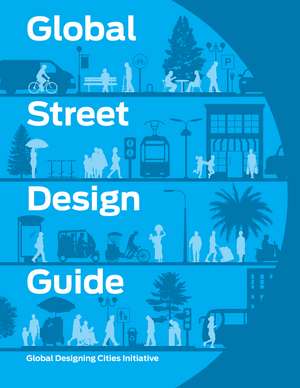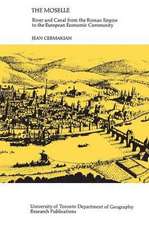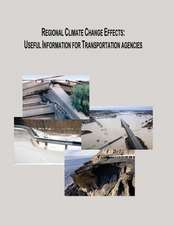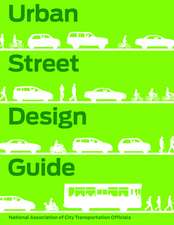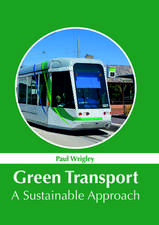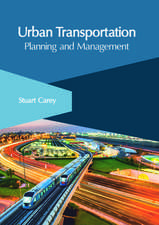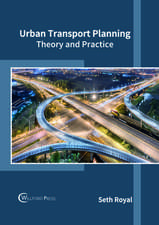Global Street Design Guide
Autor Rockefeller Philanthropy Advisors, Inc./Global Designing Cities Initiativeen Limba Engleză Hardback – 13 oct 2016
Each
year,
1.2
million
people
die
from
traffic
fatalities,
highlighting
the
need
to
design
streets
that
offer
safe
and
enticing
travel
choices
for
all
people.
Cities
around
the
world
are
facing
the
same
challenges
as
cities
in
the
US,
and
many
of
these
problems
are
rooted
in
outdated
codes
and
standards.
The Global Street Design Guide is a timely resource that sets a global baseline for designing streets and public spaces and redefines the role of streets in a rapidly urbanizing world. The guide will broaden how to measure the success of urban streets to include: access, safety, mobility for all users, environmental quality, economic benefit, public health, and overall quality of life. The first-ever worldwide standards for designing city streets and prioritizing safety, pedestrians, transit, and sustainable mobility are presented in the guide. Participating experts from global cities have helped to develop the principles that organize the guide. The Global Street Design Guide builds off the successful tools and tactics defined in NACTO’s Urban Street Design Guide andUrban Bikeway Design Guide while addressing a variety of street typologies and design elements found in various contexts around the world.
This innovative guide will inspire leaders, inform practitioners, and empower communities to realize the potential in their public space networks. It will help cities unlock the potential of streets as safe, accessible, and economically sustainable places.
Example cities include: Bangalore, India; Buenos Aires, Argentina; Paris, France; Copenhagen, Denmark; Seoul, Korea; Medellin, Colombia; Toronto, Canada; Istanbul, Turkey; Auckland, New Zealand; Melbourne, Australia; New York, USA; and San Francisco, USA.
The Global Street Design Guide is a timely resource that sets a global baseline for designing streets and public spaces and redefines the role of streets in a rapidly urbanizing world. The guide will broaden how to measure the success of urban streets to include: access, safety, mobility for all users, environmental quality, economic benefit, public health, and overall quality of life. The first-ever worldwide standards for designing city streets and prioritizing safety, pedestrians, transit, and sustainable mobility are presented in the guide. Participating experts from global cities have helped to develop the principles that organize the guide. The Global Street Design Guide builds off the successful tools and tactics defined in NACTO’s Urban Street Design Guide andUrban Bikeway Design Guide while addressing a variety of street typologies and design elements found in various contexts around the world.
This innovative guide will inspire leaders, inform practitioners, and empower communities to realize the potential in their public space networks. It will help cities unlock the potential of streets as safe, accessible, and economically sustainable places.
Example cities include: Bangalore, India; Buenos Aires, Argentina; Paris, France; Copenhagen, Denmark; Seoul, Korea; Medellin, Colombia; Toronto, Canada; Istanbul, Turkey; Auckland, New Zealand; Melbourne, Australia; New York, USA; and San Francisco, USA.
Preț: 333.89 lei
Nou
Puncte Express: 501
Preț estimativ în valută:
63.90€ • 66.46$ • 52.75£
63.90€ • 66.46$ • 52.75£
Carte disponibilă
Livrare economică 25 martie-08 aprilie
Livrare express 08-14 martie pentru 75.01 lei
Preluare comenzi: 021 569.72.76
Specificații
ISBN-13: 9781610917018
ISBN-10: 1610917014
Pagini: 442
Ilustrații: Full color
Dimensiuni: 210 x 273 x 23 mm
Greutate: 1.36 kg
Ediția:None
Editura: Island Press
Colecția Island Press
ISBN-10: 1610917014
Pagini: 442
Ilustrații: Full color
Dimensiuni: 210 x 273 x 23 mm
Greutate: 1.36 kg
Ediția:None
Editura: Island Press
Colecția Island Press
Notă biografică
Supported by Bloomberg Philanthropies and launched in 2014, the Global Designing Cities Initiative (GDCI) focuses on the critical role of streets around the world. GDCI, working in partnership with the National Association of City Transportation Officials (NACTO), is committed to raising the state of the practice for street design and transportation by building a common vision, sharing data, peer-to-peer exchanges and regular communication among international cities. NACTO is a membership network that provides support and resources for city transportation officials in North American cities of all sizes.
Cuprins
Forewords
About the Guide
Streets Around the World
Global Influences
A New Approach to Street Design
How to Use the Guide
A. About Streets
1. Defining Streets
1.1 What is a Street
1.2 Shifting the Measure of Success
1.3 The Economy of Streets
1.4 Streets for Environmental Sustainability
1.5 Safe Streets Save Lives
1.6 Streets Shape People
1.7 Multimodal Streets Serve More People
1.8 What is Possible
2 Shaping Streets
2.1 The Process of Shaping Streets
2.2 Aligning with City and Regional Agendas
2.3 Involving the Right Stakeholders
2.4 Setting a Project Vision
2.5 Communication and Engagement
2.6 Costs and Budgets
2.7 Phasing and Interim Strategies
2.8 Coordination and Project Management
2.9 Implementation and Materials
2.10 Management
2.11 Maintenance
2.12 Institutionalizing Change
3 Measuring and Evaluating Streets
3.1 How to Measure Streets
3.2 Summary Chart
3.3 Measuring the Street
B. Street Design Guidance
4 Designing Streets for Great Cities
4.1 Key Design Principles
5 Designing Streets for Place
5.1 Defining Place
5.2 Local and Regional Contexts
5.3 Immediate Context
5.4 Changing Contexts
6 Designing Streets for People
6.1 A Variety of Street Users
6.2 Comparing Street Users
6.3 Designing for Pedestrians
6.3.1 Overview
Speed
Variations
6.3.2 Pedestrian Networks
6.3.3 Pedestrian Toolbox
6.3.4 Sidewalks
Sidewalk Types
Geometry
Design Guidance
6.3.5 Pedestrian Crossings
Design Guidance
Crossing Types
6.3.6 Pedestrian Refuges
6.3.7 Sidewalk Extensions
6.3.8 Universal Accessibility 6.3.9 Wayfinding
6.4 Designing for Cyclists
6.4.1 Overview
Speed
Variations
Levels of Comfort
6.4.2 Cycle Networks
6.4.3 Cyclist Toolbox
6.4.4 Cycle Facilities
Facility Types
Geometry
Cycle Facilities at Transit Stops
Protected Cycle Facilities at Intersections
Cycle Signals
Filtered Permeability
Conflict Zone Markings
6.4.5 Cycle Share
6.5 Designing for Transit Riders
6.5.1 Overview
Speed
Variations
6.5.2 Transit Networks
6.5.3 Transit Toolbox
6.5.4 Transit Facilities
Facility Types
Geometry
6.5.5 Transit Stops
Stop Types
Stop Placement 6.5.6 Additional Guidance Sharing Transit Lanes with Cycles Contraflow Lanes on One-Way Streets Rest Areas
6.6 Designing for Motorists
6.6.1 Overview
Speed
Variations
6.6.2 Motorist Networks
6.6.3 Motorist Toolbox
6.6.4 Travel Lanes
Geometry
6.6.5 Corner Radii
6.6.6 Visibility and Sight Distance
6.6.7 Traffic Calming Strategies
6.7 Designing for Freight and Service Operators
6.7.1 Overview
Speed
Variations
6.7.2 Freight Networks
6.7.3 Freight Toolbox
6.7.4 Geometry
6.7.5 Freight Management and Safety
6.8 Designing for People Doing Business
6.8.1 Overview
Variations
6.8.2 People Doing Business Toolbox
6.8.3 Geometry
6.8.4 Siting Guidance
7 Utilities and Infrastructure
7.1 Utilities
7.1.1 Underground Utilities Design Guidance
7.1.2 Underground Utilities Placement Guidance
7.2 Green Infrastructure and Stormwater
Management
7.2.1 Green Infrastructure Design Guidance
7.2.2 Benefits of Green Infrastructure
7.3 Lighting and Technology
7.3.1 Lighting Design Guidance
8 Operational and Management Strategies
8.1 Overview
8.2 General Strategies
8.3 Demand Management
8.4 Network Management
8.5 Volume and Access Management
8.6 Parking and Curbside Management
8.7 Speed Management
8.8 Signs and Signals
9 Design Controls
9.1 Design Speed
9.2 Design Vehicle and Control Vehicle
9.3 Design Year and Modal Capacity
9.4 Design Hour
C. Street Transformations
10 Streets
10.1 Street Design Strategies 10.2 Street Typologies
10.3 Pedestrian-Priority Spaces
10.3.1 Pedestrian-Only Streets
Example 1: 18 m
Example 2: 22 m
Case Study: Strøget, Copenhagen, Denmark
10.3.2 Laneways and Alleys
Example 1: 8 m
Example 2: 10 m
Case Study: Laneways of Melbourne, Australia
10.3.3 Parklets
Example 1
Case Study: Pavement to Parks,
San Francisco, USA
10.3.4 Pedestrian Plazas
Example 1
Plaza Configurations
Case Study: Plaza Program,
New York City, USA
10.4 Shared Streets
10.4.1 Commercial Shared Streets Example 1: 12 m
Example 2: 14 m
Case Study: Fort Street, Auckland,
New Zealand
10.4.2 Residential Shared Streets Example 1: 9 m
Example 2: 10 m
Case Study: Van Gogh Walk, London, UK
10.5 Neighborhood Streets
10.5.1 Residential Streets Example 1: 13 m
Example 2: 16 m
Example 3: 24 m
Case Study: Bourke St., Sydney, Australia
10.5.2 Neighborhood Main Streets
Example 1: 18 m
Example 2: 22 m
Example 3: 30 m
Case Study: St. Marks Rd., Bangalore, India
10.6 Avenues and Boulevards
10.6.1 Central One-Way Streets Example 1: 18 m
Example 2: 25 m
Example 3: 31 m
Case Study: Second Ave., New York City, USA
10.6.2 Central Two-Way Streets
Example 1: 20 m
Example 2: 30 m
Example 3: 40 m
Case Study: Götgatan, Stockholm, Sweden
10.6.3 Transit Streets
Example 1: 16 m
Example 2: 32 m
Example 3: 35 m
Case Study: Swanston St., Melbourne,
Australia
10.6.4 Large Streets with Transit
Example 1: 32 m
Example 2: 38 m
Case Study: Boulevard de Magenta,
Paris, France
10.6.5 Grand Streets
Example 1: 52 m
Example 2: 62 m
Example 3: 76 m
Case Study: Av. 9 de Julio, Buenos Aires,
Argentina
10.7 Special Conditions
10.7.1 Elevated Structure Improvement
Example: 34 m Case Study: A8ernA, Zaanstad, The Netherlands
10.7.2 Elevated Structure Removal
Example: 47 m
Case Study: Cheonggyecheon, Seoul,
South Korea
10.7.3 Streets to Streams
Example: 40 m
Case Study: 21st Street, Paso Robles, USA
10.7.4 Temporary Street Closures
Example: 21 m
Types of Temporary Street Closures
Case Study: Raahgiri Day, Gurgaon, India
10.7.5 Post-Industrial Revitalization
Example: 20 m
Case Study: Jellicoe St., Auckland,
New Zealand
10.7.6 Waterfront and Parkside Streets
Example: 30 m
Case Study: Queens Quay, Toronto, Canada 10.7.7 Historic Streets
Example
Case Study: Historic Peninsula,
Istanbul, Turkey
10.8 Streets in Informal Areas
10.8.1 Overview
10.8.2 Existing Conditions
10.8.3 Recommendations
Case Study 1: Calle 107, Medellin, Colombia
Case Study 2: Khayelitsha, Cape Town,
South Africa
Case Study 3: Street of Korogocho,
Nairobi, Kenya
11 Intersections
11.1 Intersection Design Strategies 11.2 Intersection Analysis 11.3 Intersection Redesign 11.4 Mini Roundabout 11.5 Small Raised Intersection 11.6 Neighborhood Gateway Intersection 11.7 Intersection of Two-Way and One-Way Streets 11.8 Major Intersection: Reclaiming the Corners 11.9 Major Intersection: Squaring the Circle 11.10 Major Intersection: Cycle Protection 11.11 Complex Intersection: Adding Public Plazas 11.12 Complex Intersection: Improving Traffic Circles 11.13 Complex Intersection: Increasing Permeability
Resources
Acknowledgements
Key Terms
Notes
References
Appendix
A. Metric Charts
Physical and Operational Changes
Use and Functional Changes
Evaluating the Impacts
B. Summary Chart of Typologies Illustrated
C User Section Geometries
D. Assumptions for Intersection Dimensions
Index
Island Press Colophon
About the Guide
Streets Around the World
Global Influences
A New Approach to Street Design
How to Use the Guide
A. About Streets
1. Defining Streets
1.1 What is a Street
1.2 Shifting the Measure of Success
1.3 The Economy of Streets
1.4 Streets for Environmental Sustainability
1.5 Safe Streets Save Lives
1.6 Streets Shape People
1.7 Multimodal Streets Serve More People
1.8 What is Possible
2 Shaping Streets
2.1 The Process of Shaping Streets
2.2 Aligning with City and Regional Agendas
2.3 Involving the Right Stakeholders
2.4 Setting a Project Vision
2.5 Communication and Engagement
2.6 Costs and Budgets
2.7 Phasing and Interim Strategies
2.8 Coordination and Project Management
2.9 Implementation and Materials
2.10 Management
2.11 Maintenance
2.12 Institutionalizing Change
3 Measuring and Evaluating Streets
3.1 How to Measure Streets
3.2 Summary Chart
3.3 Measuring the Street
B. Street Design Guidance
4 Designing Streets for Great Cities
4.1 Key Design Principles
5 Designing Streets for Place
5.1 Defining Place
5.2 Local and Regional Contexts
5.3 Immediate Context
5.4 Changing Contexts
6 Designing Streets for People
6.1 A Variety of Street Users
6.2 Comparing Street Users
6.3 Designing for Pedestrians
6.3.1 Overview
Speed
Variations
6.3.2 Pedestrian Networks
6.3.3 Pedestrian Toolbox
6.3.4 Sidewalks
Sidewalk Types
Geometry
Design Guidance
6.3.5 Pedestrian Crossings
Design Guidance
Crossing Types
6.3.6 Pedestrian Refuges
6.3.7 Sidewalk Extensions
6.3.8 Universal Accessibility 6.3.9 Wayfinding
6.4 Designing for Cyclists
6.4.1 Overview
Speed
Variations
Levels of Comfort
6.4.2 Cycle Networks
6.4.3 Cyclist Toolbox
6.4.4 Cycle Facilities
Facility Types
Geometry
Cycle Facilities at Transit Stops
Protected Cycle Facilities at Intersections
Cycle Signals
Filtered Permeability
Conflict Zone Markings
6.4.5 Cycle Share
6.5 Designing for Transit Riders
6.5.1 Overview
Speed
Variations
6.5.2 Transit Networks
6.5.3 Transit Toolbox
6.5.4 Transit Facilities
Facility Types
Geometry
6.5.5 Transit Stops
Stop Types
Stop Placement 6.5.6 Additional Guidance Sharing Transit Lanes with Cycles Contraflow Lanes on One-Way Streets Rest Areas
6.6 Designing for Motorists
6.6.1 Overview
Speed
Variations
6.6.2 Motorist Networks
6.6.3 Motorist Toolbox
6.6.4 Travel Lanes
Geometry
6.6.5 Corner Radii
6.6.6 Visibility and Sight Distance
6.6.7 Traffic Calming Strategies
6.7 Designing for Freight and Service Operators
6.7.1 Overview
Speed
Variations
6.7.2 Freight Networks
6.7.3 Freight Toolbox
6.7.4 Geometry
6.7.5 Freight Management and Safety
6.8 Designing for People Doing Business
6.8.1 Overview
Variations
6.8.2 People Doing Business Toolbox
6.8.3 Geometry
6.8.4 Siting Guidance
7 Utilities and Infrastructure
7.1 Utilities
7.1.1 Underground Utilities Design Guidance
7.1.2 Underground Utilities Placement Guidance
7.2 Green Infrastructure and Stormwater
Management
7.2.1 Green Infrastructure Design Guidance
7.2.2 Benefits of Green Infrastructure
7.3 Lighting and Technology
7.3.1 Lighting Design Guidance
8 Operational and Management Strategies
8.1 Overview
8.2 General Strategies
8.3 Demand Management
8.4 Network Management
8.5 Volume and Access Management
8.6 Parking and Curbside Management
8.7 Speed Management
8.8 Signs and Signals
9 Design Controls
9.1 Design Speed
9.2 Design Vehicle and Control Vehicle
9.3 Design Year and Modal Capacity
9.4 Design Hour
C. Street Transformations
10 Streets
10.1 Street Design Strategies 10.2 Street Typologies
10.3 Pedestrian-Priority Spaces
10.3.1 Pedestrian-Only Streets
Example 1: 18 m
Example 2: 22 m
Case Study: Strøget, Copenhagen, Denmark
10.3.2 Laneways and Alleys
Example 1: 8 m
Example 2: 10 m
Case Study: Laneways of Melbourne, Australia
10.3.3 Parklets
Example 1
Case Study: Pavement to Parks,
San Francisco, USA
10.3.4 Pedestrian Plazas
Example 1
Plaza Configurations
Case Study: Plaza Program,
New York City, USA
10.4 Shared Streets
10.4.1 Commercial Shared Streets Example 1: 12 m
Example 2: 14 m
Case Study: Fort Street, Auckland,
New Zealand
10.4.2 Residential Shared Streets Example 1: 9 m
Example 2: 10 m
Case Study: Van Gogh Walk, London, UK
10.5 Neighborhood Streets
10.5.1 Residential Streets Example 1: 13 m
Example 2: 16 m
Example 3: 24 m
Case Study: Bourke St., Sydney, Australia
10.5.2 Neighborhood Main Streets
Example 1: 18 m
Example 2: 22 m
Example 3: 30 m
Case Study: St. Marks Rd., Bangalore, India
10.6 Avenues and Boulevards
10.6.1 Central One-Way Streets Example 1: 18 m
Example 2: 25 m
Example 3: 31 m
Case Study: Second Ave., New York City, USA
10.6.2 Central Two-Way Streets
Example 1: 20 m
Example 2: 30 m
Example 3: 40 m
Case Study: Götgatan, Stockholm, Sweden
10.6.3 Transit Streets
Example 1: 16 m
Example 2: 32 m
Example 3: 35 m
Case Study: Swanston St., Melbourne,
Australia
10.6.4 Large Streets with Transit
Example 1: 32 m
Example 2: 38 m
Case Study: Boulevard de Magenta,
Paris, France
10.6.5 Grand Streets
Example 1: 52 m
Example 2: 62 m
Example 3: 76 m
Case Study: Av. 9 de Julio, Buenos Aires,
Argentina
10.7 Special Conditions
10.7.1 Elevated Structure Improvement
Example: 34 m Case Study: A8ernA, Zaanstad, The Netherlands
10.7.2 Elevated Structure Removal
Example: 47 m
Case Study: Cheonggyecheon, Seoul,
South Korea
10.7.3 Streets to Streams
Example: 40 m
Case Study: 21st Street, Paso Robles, USA
10.7.4 Temporary Street Closures
Example: 21 m
Types of Temporary Street Closures
Case Study: Raahgiri Day, Gurgaon, India
10.7.5 Post-Industrial Revitalization
Example: 20 m
Case Study: Jellicoe St., Auckland,
New Zealand
10.7.6 Waterfront and Parkside Streets
Example: 30 m
Case Study: Queens Quay, Toronto, Canada 10.7.7 Historic Streets
Example
Case Study: Historic Peninsula,
Istanbul, Turkey
10.8 Streets in Informal Areas
10.8.1 Overview
10.8.2 Existing Conditions
10.8.3 Recommendations
Case Study 1: Calle 107, Medellin, Colombia
Case Study 2: Khayelitsha, Cape Town,
South Africa
Case Study 3: Street of Korogocho,
Nairobi, Kenya
11 Intersections
11.1 Intersection Design Strategies 11.2 Intersection Analysis 11.3 Intersection Redesign 11.4 Mini Roundabout 11.5 Small Raised Intersection 11.6 Neighborhood Gateway Intersection 11.7 Intersection of Two-Way and One-Way Streets 11.8 Major Intersection: Reclaiming the Corners 11.9 Major Intersection: Squaring the Circle 11.10 Major Intersection: Cycle Protection 11.11 Complex Intersection: Adding Public Plazas 11.12 Complex Intersection: Improving Traffic Circles 11.13 Complex Intersection: Increasing Permeability
Resources
Acknowledgements
Key Terms
Notes
References
Appendix
A. Metric Charts
Physical and Operational Changes
Use and Functional Changes
Evaluating the Impacts
B. Summary Chart of Typologies Illustrated
C User Section Geometries
D. Assumptions for Intersection Dimensions
Index
Island Press Colophon
Recenzii
"Streets
are
the
foundation
of
a
city's
entire
social
structure—getting
around,
working,
living,
shopping,
and
playing.
With
this
guide,
cities
have,
for
the
first
time,
a
universal
resource
for
creating
cities
that
operate
for
everyone
who
uses
them."
"This invaluable guide brings together extremely useful information and metrics that can assist city administrations, urban designers, planners, landscape architects, and the public in forging new directions in street design...the Global Street Design Guide should find its way onto the shelves of all design and planning firms responsible for improving urban streets, regardless of where they practice."
"Smart street design improves lives in so many ways, from reducing emissions that cause harmful air pollution and drive climate change, to making streets safer and helping local businesses. The Global Street Design Guide is a powerful resource that can help cities around the world become safer and stronger."
"For more than a century, street life was what grew through the cracks in pavement—a liveliness that thrived despite the asphalt and traffic. The Global Street Design Guide starts from an opposite principle, that we can't wait for streets to produce human outliers that survive against the odds, but that we must instead design them to make active, engaging street life inevitable."
"Cities are undergoing a street design revolution, and the Global Street Design Guide is the first document to capture the brave new world of strategies that are transforming cities on every continent. Drawn from life and sourced with real-world examples, this guide establishes a new categorical imperative for safer streets that level the playing field for transit, bike riders, and pedestrians. It creates a new international language for urban livability, mobility, and economy."
Descriere
Each year, 1.2 million people die from traffic fatalities, highlighting the need to design streets that offer safe and enticing travel choices for all people. Cities around the world are facing the same challenges as cities in the US, and many of these problems are rooted in outdated codes and standards.
The Global Street Design Guide is a timely resource that sets a global baseline for designing streets and public spaces and redefines the role of streets in a rapidly urbanizing world. The guide will broaden how to measure the success of urban streets to include: access, safety, mobility for all users, environmental quality, economic benefit, public health, and overall quality of life. The first-ever worldwide standards for designing city streets and prioritizing safety, pedestrians, transit, and sustainable mobility are presented in the guide. Participating experts from global cities have helped to develop the principles that organize the guide. The Global Street Design Guide builds off the successful tools and tactics defined in NACTO’s Urban Street Design Guide and Urban Bikeway Design Guide while addressing a variety of street typologies and design elements found in various contexts around the world.
This innovative guide will inspire leaders, inform practitioners, and empower communities to realize the potential in their public space networks. It will help cities unlock the potential of streets as safe, accessible, and economically sustainable places.
Example cities include: Bangalore, India; Buenos Aires, Argentina; Paris, France; Copenhagen, Denmark; Seoul, Korea; Medellin, Colombia; Toronto, Canada; Istanbul, Turkey; Auckland, New Zealand; Melbourne, Australia; New York, USA; and San Francisco, USA.
The Global Street Design Guide is a timely resource that sets a global baseline for designing streets and public spaces and redefines the role of streets in a rapidly urbanizing world. The guide will broaden how to measure the success of urban streets to include: access, safety, mobility for all users, environmental quality, economic benefit, public health, and overall quality of life. The first-ever worldwide standards for designing city streets and prioritizing safety, pedestrians, transit, and sustainable mobility are presented in the guide. Participating experts from global cities have helped to develop the principles that organize the guide. The Global Street Design Guide builds off the successful tools and tactics defined in NACTO’s Urban Street Design Guide and Urban Bikeway Design Guide while addressing a variety of street typologies and design elements found in various contexts around the world.
This innovative guide will inspire leaders, inform practitioners, and empower communities to realize the potential in their public space networks. It will help cities unlock the potential of streets as safe, accessible, and economically sustainable places.
Example cities include: Bangalore, India; Buenos Aires, Argentina; Paris, France; Copenhagen, Denmark; Seoul, Korea; Medellin, Colombia; Toronto, Canada; Istanbul, Turkey; Auckland, New Zealand; Melbourne, Australia; New York, USA; and San Francisco, USA.
